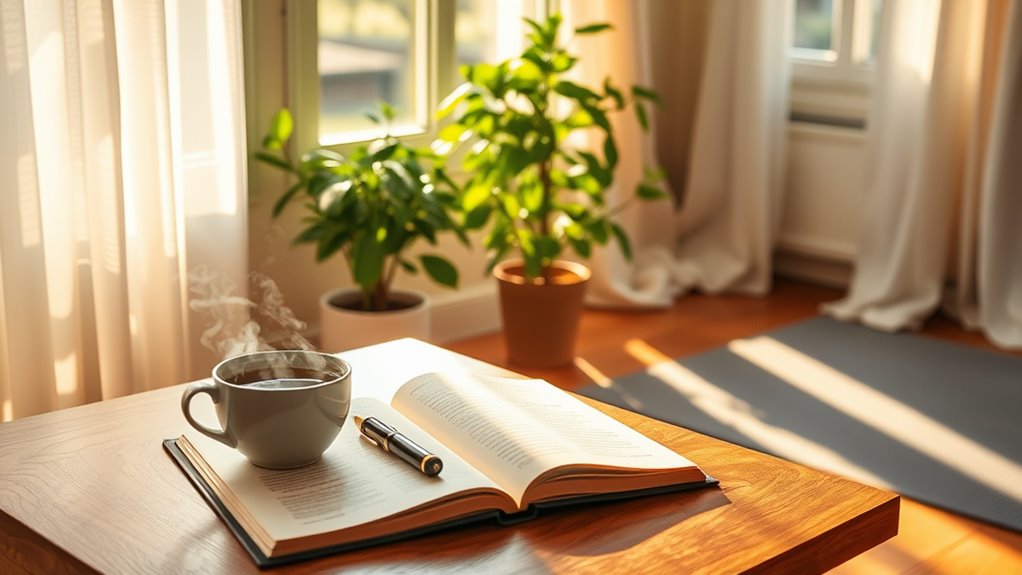How to Clear Your Mind in 10 Minutes With Meditation
To clear your mind in just ten minutes, find a quiet space and sit comfortably. Close your eyes and focus on your breath—inhale deeply, then exhale slowly. If thoughts arise, acknowledge them without judgment, then gently bring your awareness back to your breath. Visualize calmness washing over you, filling your mind with peace. Keep practicing this technique daily, and you’ll notice improvements in clarity and calm. Discover more ways to enhance your meditation experience.
Key Takeaways
- Find a quiet and comfortable space where you can relax without distractions for effective meditation.
- Set a timer for 10 minutes to keep your practice focused and structured.
- Begin by taking deep breaths, focusing on the natural rhythm of inhalations and exhalations to anchor your awareness.
- Acknowledge any thoughts that arise without judgment, gently redirecting your focus back to your breath.
- Visualize your breath as a wave, allowing it to ebb and flow, promoting mental clarity and calmness.
Understanding the Benefits of Meditation
Meditation offers a treasure trove of benefits that can transform your mental landscape. When you engage in focused breathing and meditation, you activate a profound shift within yourself.
This practice sharpens your concentration, enhances emotional resilience, and cultivates a sense of inner peace. By mastering your breath, you’ll find that stress melts away, allowing you to approach challenges with clarity and confidence.
The more you commit to this practice, the more adept you become at managing anxiety and racing thoughts. You’ll establish a powerful connection between mind and body, promoting overall well-being. Additionally, incorporating effective breathing techniques can further amplify the positive effects of your meditation practice.
Setting the Right Environment
To truly benefit from meditation, creating the right environment is vital.
Begin by selecting a quiet space, free from distractions. Dim the lights or use candles to create a warm ambiance that invites calmness. Consider incorporating soothing elements like soft music or nature sounds, which can enhance your focus.
You might also want to use scents—aromatherapy can greatly elevate your experience. Choose essential oils that promote relaxation, such as lavender or eucalyptus. Additionally, integrating spa-like elements such as plush towels and soft pillows can further enhance your comfort.
Ascertain the area is comfortable and inviting; clean surfaces and minimal clutter can help your mind settle.
By intentionally crafting your meditation space, you set the stage for deeper exploration and a more profound connection with your practice.
Embrace this environment as your sanctuary for introspection.
Finding a Comfortable Position
Finding a comfortable position is essential for effective meditation, as it allows you to focus without physical distractions. Here are four key options to take into account:
-
Seated on a Chair: Sit up straight with your feet flat on the ground. This position offers stability and comfort.
-
Cross-Legged on the Floor: Sit on a cushion or mat with your legs crossed. Keep your back straight to promote alertness.
-
Kneeling: Use a cushion under your legs for support. This position helps maintain a grounded yet open posture.
-
Lying Down: If sitting feels difficult, lie on your back with arms relaxed at your sides. Just make sure you stay alert and avoid falling asleep.
Incorporating breathing techniques into your meditation can further enhance your experience by promoting relaxation and mental clarity. Choose a position that feels right for you, and settle in to enhance your meditation experience.
Focusing on Your Breath
As you settle into your chosen position, focusing on your breath becomes a powerful anchor for your meditation practice.
Pay attention to the natural rhythm of your inhalations and exhalations. Notice how each breath flows effortlessly in and out, grounding you in the present moment.
When your mind begins to wander, gently bring your awareness back to your breath. This practice cultivates concentration and enhances your mindfulness.
You might visualize your breath as a wave, rising and falling, or simply observe the sensations it creates in your body.
Embrace any thoughts that arise without judgment, letting them drift away like clouds. Engaging in this simple practice can help you breathe deeply and foster a sense of calmness that enhances your overall meditation experience.
A Simple Breathing Technique
One effective breathing technique to enhance your meditation involves a simple pattern of inhaling and exhaling.
By focusing on your breath, you can achieve a deeper state of relaxation and clarity. Incorporating breathing techniques into your practice can significantly reduce tension and improve your overall well-being.
Follow these steps to master this technique:
-
Find Your Space: Sit comfortably in a quiet environment where you won’t be disturbed.
-
Inhale Deeply: Breathe in through your nose for a count of four, filling your lungs completely.
-
Hold: Retain the breath for a count of four, allowing the oxygen to energize your body.
-
Exhale Slowly: Release your breath through your mouth for a count of six, letting go of tension.
Repeat this cycle several times, and you’ll notice your mind becoming clearer and more focused.
Practicing Mindfulness
After honing your breathing technique, you can deepen your meditation practice by incorporating mindfulness.
Begin by anchoring your awareness in the present moment. Focus on your senses—notice the sounds around you, the sensations on your skin, and even the taste in your mouth. Allow thoughts to arise without judgment; acknowledge them and gently guide your attention back to your breath.
This cultivated awareness sharpens your ability to stay present throughout your day. Practice observing your emotions and thoughts as they come and go, fostering a non-reactive mindset.
Visualizing Calmness
Visualizing calmness can be a powerful tool in your meditation practice. To harness this technique effectively, follow these steps:
-
Choose Your Space: Picture a serene environment—this could be a tranquil beach or a peaceful forest.
-
Engage Your Senses: Visualize the sounds, smells, and sensations of your chosen space. Imagine the gentle waves or the rustle of leaves.
-
Breathe Deeply: As you immerse yourself in this imagery, sync your breath with the rhythm of your visualization. Inhale the calmness, exhale tension.
-
Anchor the Feeling: Establish a mental anchor, like a color or symbol, representing your serene state. Whenever you feel stressed, recall this image to reclaim your tranquility.
Acknowledging and Letting Go of Thoughts
As you sit in meditation, acknowledging and letting go of thoughts is essential for finding inner peace.
You’ll likely notice a stream of thoughts surfacing, pulling your focus away from the present moment. Instead of pushing them aside, recognize each thought without judgment.
Imagine them as clouds drifting across the sky—acknowledge their presence, then watch them float away. This practice cultivates a sense of detachment, allowing you to maintain your center.
Remember, it’s not about silencing your mind but rather accepting thoughts as they come and go. Each time you acknowledge a thought and let it pass, you enhance your ability to remain present, sharpening your focus and deepening your state of relaxation.
Embrace this process; it’s a path to mastery.
Bringing Your Awareness Back
When you notice your mind wandering, gently bring your awareness back to your breath.
Focus on each inhale and exhale, allowing this rhythm to anchor you in the present moment.
As thoughts arise, simply observe them without judgment and return to your breath.
Focus on Breath
One effective way to bring your awareness back during meditation is by focusing on your breath.
This simple yet powerful technique helps anchor you in the present moment. Here’s how to do it effectively:
-
Inhale deeply through your nose, allowing your abdomen to expand fully.
-
Hold your breath for a brief moment, feeling the stillness within.
-
Exhale slowly through your mouth, releasing any tension or distractions.
-
Repeat the cycle, gently redirecting your mind to your breath whenever it wanders.
Observe Your Thoughts
While you meditate, observing your thoughts can be a powerful way to bring your awareness back to the present. Instead of getting caught up in the narrative of your mind, simply notice each thought as it arises. Acknowledge it without judgment, like clouds passing through the sky.
This practice helps you detach from the content of your thoughts, allowing you to see them for what they are—temporary mental events. When you find your mind wandering, gently redirect your focus back to the act of observation.
Over time, this practice will enhance your ability to remain centered and present. Embrace the discipline of observing, and watch your meditation transform as clarity and calmness emerge.
Incorporating Meditation Into Your Daily Routine
As you seek to incorporate meditation into your daily routine, finding a consistent time and space can make all the difference.
Here’s how to seamlessly integrate this practice:
-
Choose a Specific Time: Whether it’s morning or evening, pick a time that suits you. Consistency breeds habit.
-
Create a Dedicated Space: Set up a serene spot free from distractions. This signals your mind it’s time to meditate.
-
Start Small: Begin with just 5–10 minutes. Gradually increase your duration as you grow more comfortable.
-
Use Guided Sessions: Leverage apps or online resources to help you stay focused and motivated.
Frequently Asked Questions
How Often Should I Meditate for Optimal Results?
You should meditate daily for ideal results. Consistency builds your practice, enhances focus, and deepens your understanding. Even short sessions can yield profound insights. Commit to a routine, and you’ll notice significant improvements over time.
Can Meditation Help With Anxiety and Stress Management?
Imagine Sarah, who faced overwhelming stress daily. By incorporating meditation into her routine, she found clarity and calm. You can also manage anxiety effectively, enhancing your focus and resilience through consistent practice.
What Should I Do if I Can’t Concentrate?
If you can’t concentrate, try breaking tasks into smaller steps, eliminating distractions, and setting specific goals. Take short breaks to recharge your mind, and consider using techniques like mindfulness to enhance your focus and clarity.
Are There Specific Times of Day Best for Meditation?
Yes, certain times can enhance your meditation. Early mornings offer tranquility, while evenings help unwind. Experiment with different times to find when your mind’s most receptive, allowing deeper focus and clarity during your practice.
Is It Normal to Feel Restless During Meditation?
It’s completely normal to feel restless during meditation. When you notice that restlessness, acknowledge it without judgment. Redirect your focus gently, and remember, every distraction is an opportunity to deepen your practice and enhance your concentration.





